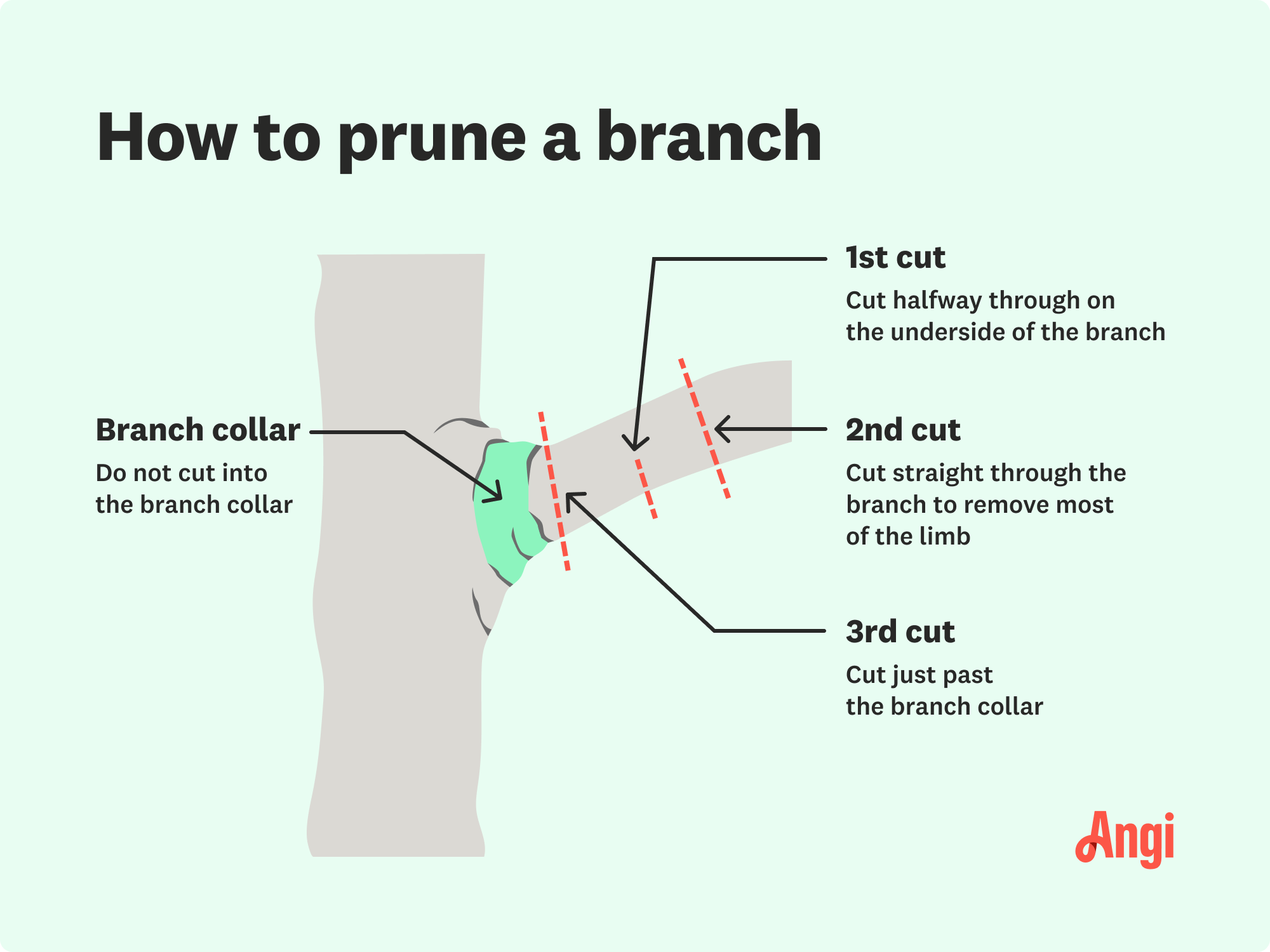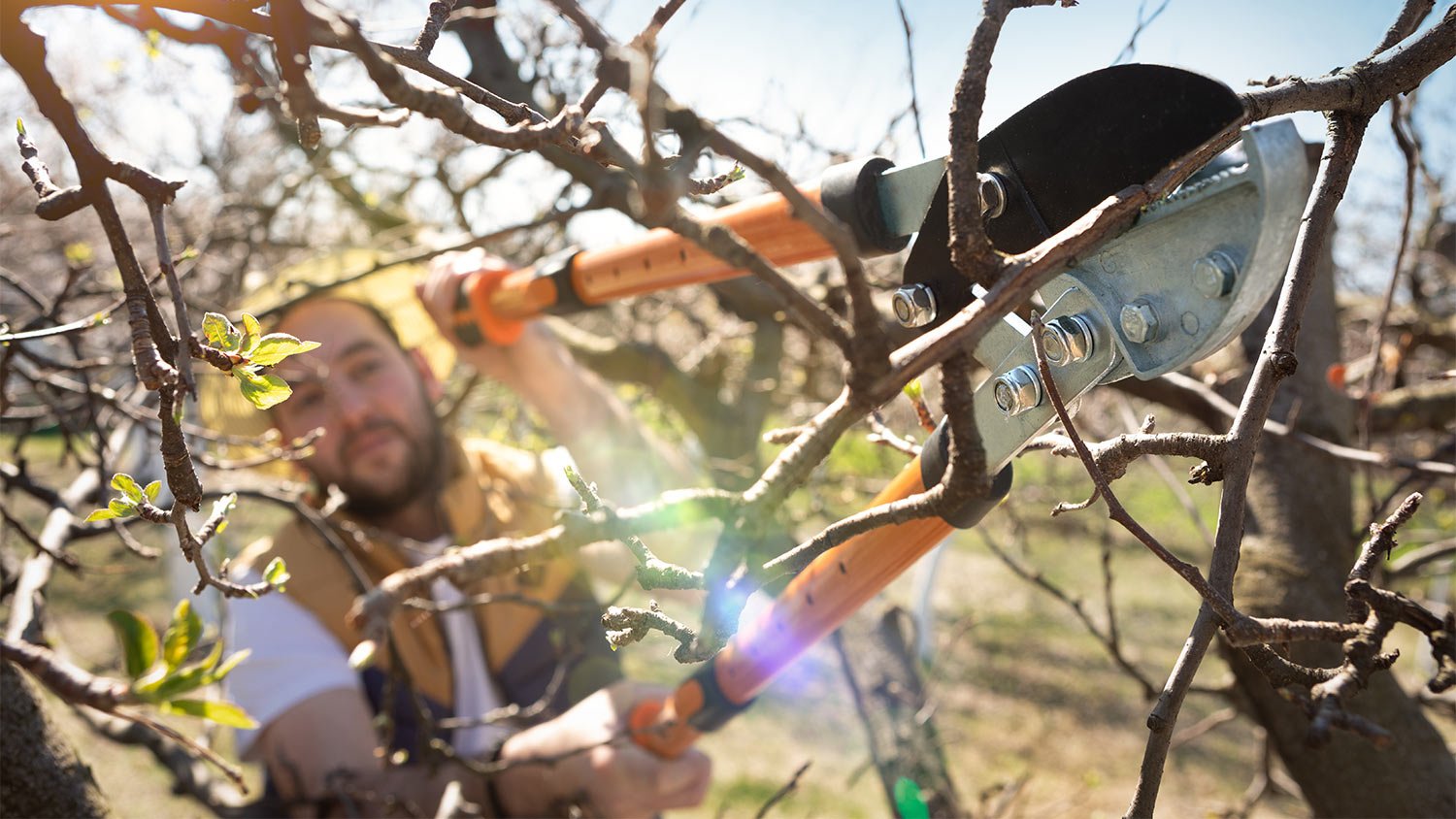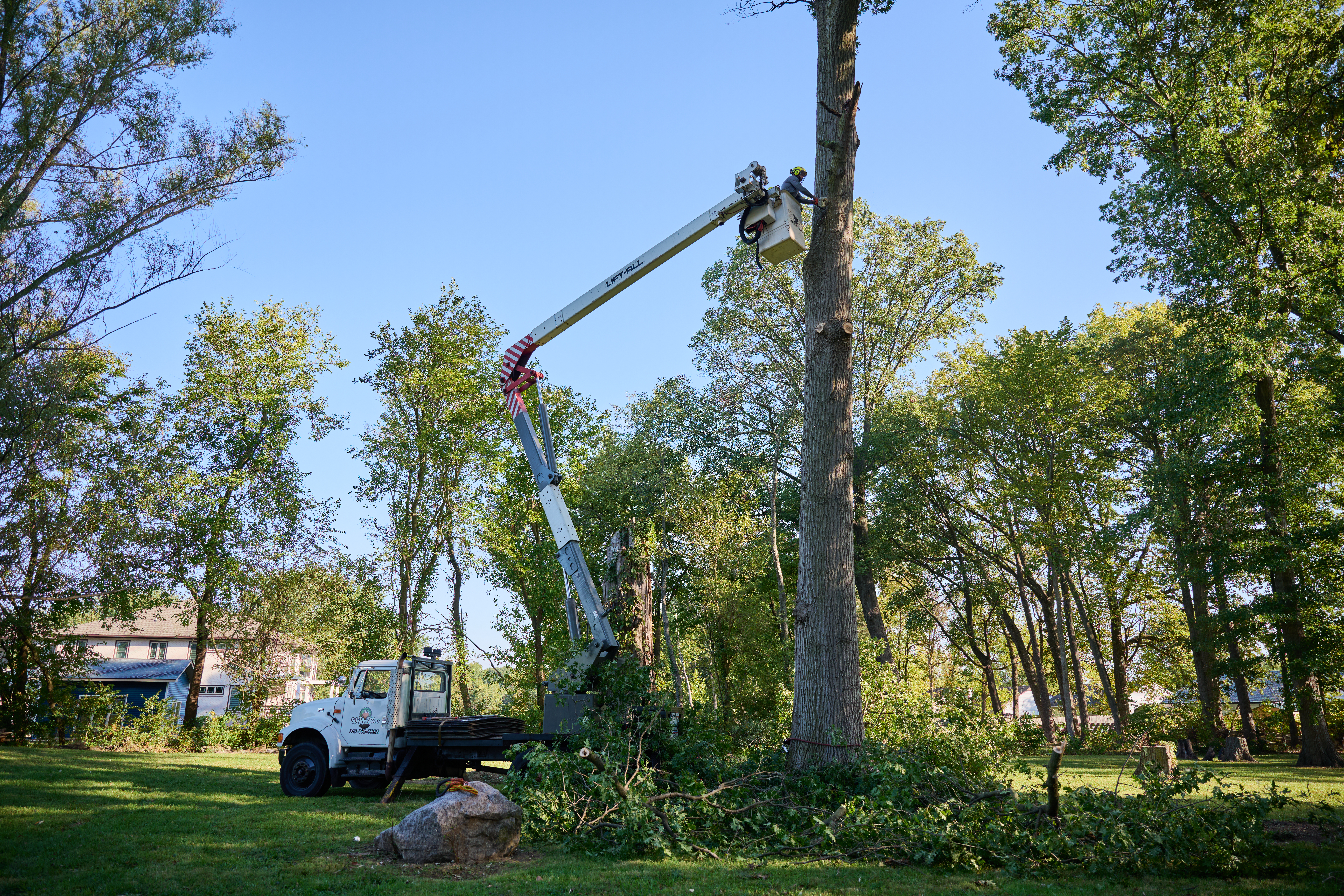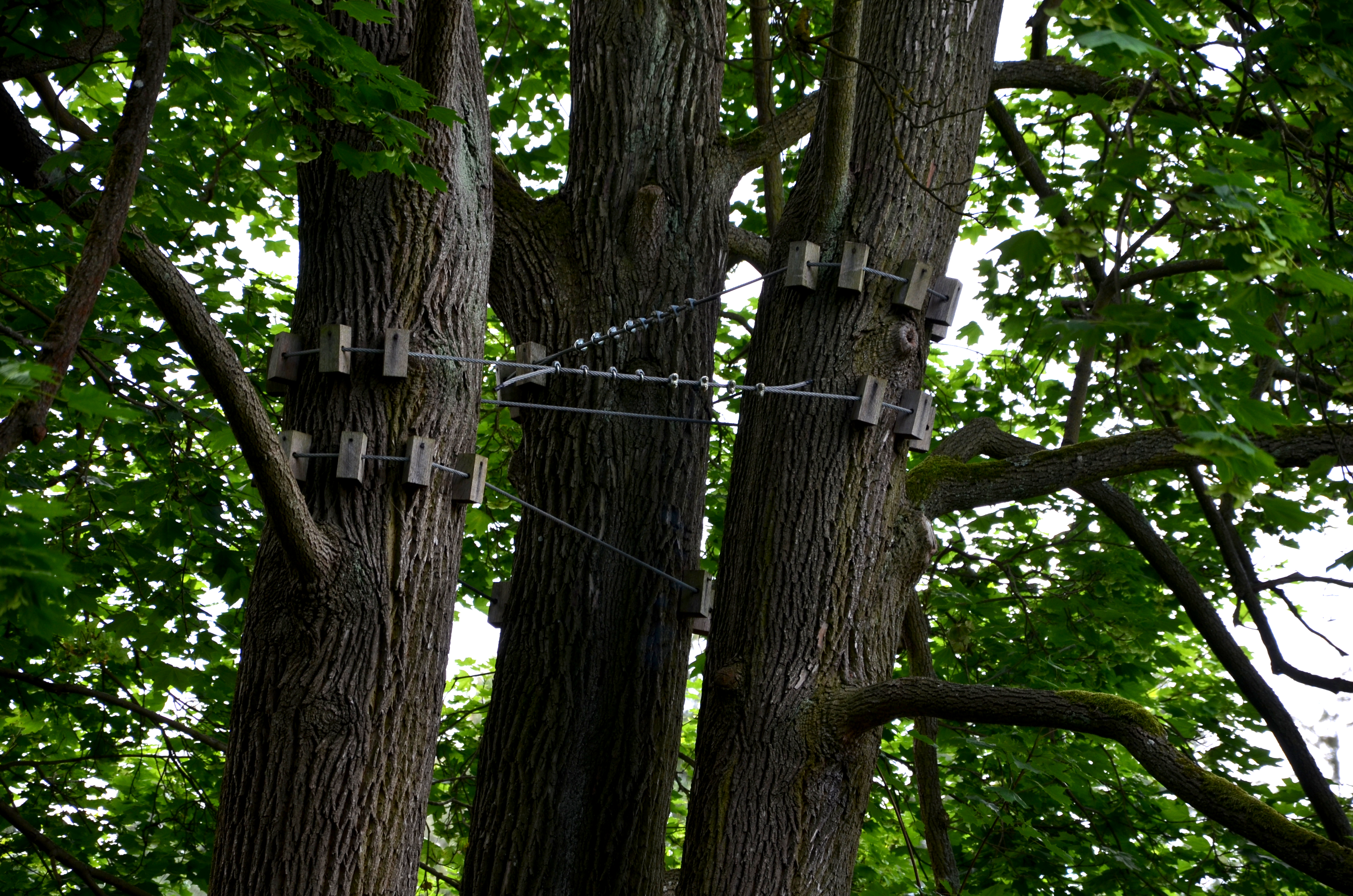Get transparent shrub removal cost info. Learn average prices, key cost factors, and tips to save on your next shrub removal project.
How to Prune a Tree: A Complete Guide
Here’s how to snip off those dead ends so your trees can flourish


- Pruning shears (for cuts up to ¾ inches in diameter)
- Loppers (for branch diameters up to 1½ inches)
- Handsaw (for cutting branches over 1 inch in diameter)
- Pole saws
- Safety goggles
- Protective gloves
- Safety helmet
Trees have so much to offer, from clean air to cool shade, fragrant blossoms, delicious fruit, and breathtaking canopies. However, you need to learn how to prune a tree to keep it in tip-top condition. When done correctly and intentionally, pruning a tree can keep it beautiful and healthy for years to come. Let’s branch out and discuss how to prune a tree, as well as why and when to do it.
When trimming trees, it's essential to prioritize safety by maintaining a safe distance from power lines, avoiding the potential fall path, and wearing protective gear. We strongly recommend hiring a professional tree service to trim large trees, given the significant safety risks.
How to Prune Trees
Pruning trees can make your blooms last longer and improve their health, but only if you do it correctly. It’s essential to use sharp tools and the proper techniques to ensure you make clean cuts and reduce the risk of disease and infection in the tree. Follow these steps to keep yourself and your tree safe.

Make a Halfway Cut on the Underside of the Branch
Make your first cut on the underside of the branch, about a foot away from the trunk and about ¼ inch above a healthy bud. Be careful not to cut too close to the bud or as doing so may kill it. The cut should go about halfway through the branch. This prevents the branch from cracking too close to the tree trunk as it falls.
Follow the Undercut With a Top Cut Slightly Further From the Trunk
Your second cut should go through the top of the branch, about an inch further away from the trunk. These two cuts allow the branch to fall off cleanly, avoiding the chance of tearing or ripping.
Make a Final Cut Just Past the Branch Collar
Once left with a stub, make your final cut on the branch side just past the branch collar. This is the raised mound where the branch meets the tree trunk. It’s important not to cut into or past the branch collar on the trunk side, as this will leave an open wound that can invite disease and hungry insects.
Pruning Methods
There are four main ways to prune a tree and each method is better for different purposes. Knowledge of different pruning techniques is why hiring a pro is usually best.

Crown thinning: This method involves removing branches throughout to better expose the remaining branches to light. More light exposure equals more photosynthesis which allows the tree to grow better and more quickly, so this technique is best for young trees that are still finding their footing and need the extra boost.
Crown raising: This pruning technique involves removing branches from just the base of a tree to provide more overhead clearance. Use this option if your tree has a lot of low-hanging branches.
Crown reduction: The goal of this method is to remove branches at the top of the tree to reduce its overall height, but is much harder to do and more inconvenient than any other pruning technique. The goal of this method is to remove branches at the top of the tree to reduce its overall height, but is much harder to do and more inconvenient than any other pruning technique. The difference between crown reduction and tree topping is that tree topping involves chopping off large branches and usually ruins the structure of a tree, whereas crown reduction isn’t so intensive. Either way, only do it when absolutely necessary, such as when tree top branches are infected or dead.
Crown cleaning: This type of pruning involves only removing branches that are dying or already dead in order to preserve the overall health of the tree.
Is Pruning the Same as Trimming?
It’s important to note that there is a difference between pruning and trimming. Trimming should happen several times a year and involves cutting off parts of branches to maintain size and shape and encourage new branch and leaf growth.
On the other hand, pruning should only happen once every two to three years and involves removing dead or sick parts of the tree. Pruning is a much more intensive process because it may require you to remove an entire branch from the base of the tree rather than just one part of it.
Pruning Trees By Age
You should also consider your tree’s age when deciding when and how to prune it. Check out some tips for pruning young vs. mature trees.
Pruning Young Trees
When pruning a younger tree, it’s important to plan your cuts thoughtfully, since one false move could cause it to grow in the wrong direction or sustain damage. For best results, cut young trees directly outside the branch collar. This method should avoid damaging the trunk if done correctly and with the proper pruning tools. Keep in mind that it’s better to make more smaller cuts now than larger ones later on in the tree’s lifespan.
Pruning Mature Trees
It’s tougher to prune mature trees effectively because they’re typically done growing and any accidental damage could permanently impact it. For best results, use saws on tough branches instead of the type of pruning tools used on younger trees. Be sure to leave the tree’s foliage alone and focus on full branches just outside the branch collar that will remove height.
When to Prune Trees

Depending on your intentions for pruning, you should opt for different times of the year. For shaping and promoting fruit, the best time to prune is during the dormant season, from December to March. This leaves them the least vulnerable to insects and disease, plus it gives them plenty of time to heal up before spring.
You should remove dead and diseased tree branches as soon as you notice them, as well as branches that pose a safety hazard. And trees that are pruned to look a certain way should be trimmed again any time they start to lose their shape—for example, whip out your garden shears when your carefully crafted hedge begins to lose its definition or when you notice more dead leaves on a tree than usual (and it isn’t during fall).
Pruning Best Practices

The act of pruning or trimming a tree is simple and straightforward, but you may still encounter obstacles without proper prep and the right tips. File these practices away for all your tree pruning needs.
1. Make a Pruning Plan
Remember the pruning mantra: Always prune with a purpose. Are you shaping the tree, removing obstructive tree branches, or taking out dead and diseased portions? For flowering and fruit trees, cut to remove branches until you have a balance of both upright and horizontal stems to promote a higher yield. For diseased or dead branches, cut at least 6 inches below the affected area to ensure the problem is fully removed.
Avoid pruning more than 25 percent of a tree at one time, because doing so can damage or even kill the tree. When in doubt, trim a bit less than you think. Older trees can tolerate even less foliage loss, and it’s safer to use a light touch if you’re not totally sure what you’re dealing with.
2. Leave Enough Branches to Maintain Tree Health
As a general rule, do not remove more than a quarter of the tree’s branches at once, as this can stress it out and potentially kill it. The exception is whenever you’re removing dead or diseased parts of the tree. All of these need to get removed ASAP before they can spread or take resources from healthy branches.
3. Don’t Cut Into the Trunk or Parent Branches
As you work, avoid cutting major branches that make up the core skeleton of the tree. These are vital to the tree’s health, and removing them can cause severe stress. Also, take care not to cut into or flush with the trunk. Again, this will create a wound that makes the tree vulnerable to insects and disease.
4. Prune Cherry and Plum Trees at the Exact Right Moment
This family of fruit trees is prone to something called silver leaf disease. They’ll typically contract this disease during the fall and winter from August to March when the spores are in the wind and sap production is low (higher amounts of sap help trees heal more quickly). Instead, plan on pruning any trees of this ilk from April to June to keep them healthy.
5. Don’t Use Wound Paint on Fresh Cuts
If your tree bleeds sap when you trim it, you may be tempted to use wound paint to seal it up. However, doing this may actually do more harm than good. Although sap leaks may not be appealing to look at and can weaken a tree, they aren’t fatal and will resolve themselves in due time.
Sealing these wounds may interfere with their natural healing process and potentially even trap diseases that could end up damaging it. The only time you may need to use wound paint is to protect open wounds on cherry and plum trees from silver leaf spores.
6. Contact a Pro for Specific Branches That Cross Electrical and Utility Wires
If the tree’s branches hit utility or power lines, do not attempt to prune them yourself. The risk of electrical shock is extremely high, not to mention the risk of other damages. Instead, contact your utility company and they will send someone to safely remove them for you. If your tree is also too sick to fix, you may need to hire a pro to remove it. The cost to hire a pro for tree removal ranges from $200 to $2,000.
DIY vs. Hire a Pro
When pruning, local tree pruning pros sometimes use tools like specialized saws and bracing systems to safely remove branches from large trees, and it can cost up to $1,100 to buy or rent all those same things to do it yourself. However, simply pruning a small tree for upkeep usually doesn’t require additional purchases. As long as you have shears and a ladder, you should be good to go. However, it’s best to hire a professional to tackle pruning large or older trees to guarantee healthy, effective results.
Cost to Prune Trees Professionally
The cost of professional tree pruning ranges from $75 for small, young trees to $1,500 for large, well-established trees. The bigger the tree, the higher the professional pruning cost. However, if you need to prune a large tree, it’s highly recommended to hire a tree pruning professional due to its size and the equipment required to tackle the job. While you may be able to prune small trees yourself, the high cost of renting proper equipment likely makes it more cost effective to hire a professional.
The homeowners guide to tree services
From average costs to expert advice, get all the answers you need to get your job done.
- •

The most significant factor in tree removal costs is the amount of debris. Read on to learn more about the average tree debris removal costs.

The cost of tree stump removal depends on size, removal method, location, and more. Our guide will show you how much stump removal costs.

Discover the answer to what is eating my tree trunk, why it's doing it, and what you can do to eliminate and prevent the insect problem.
Trees add natural beauty and shade to your yard, whether it’s a mighty oak or a fragrant olive tree. Learn how to protect trees during construction in this guide.

Cabling and bracing trees may help to increase longevity and prevent limbs from falling when trees are showing certain signs of distress.

